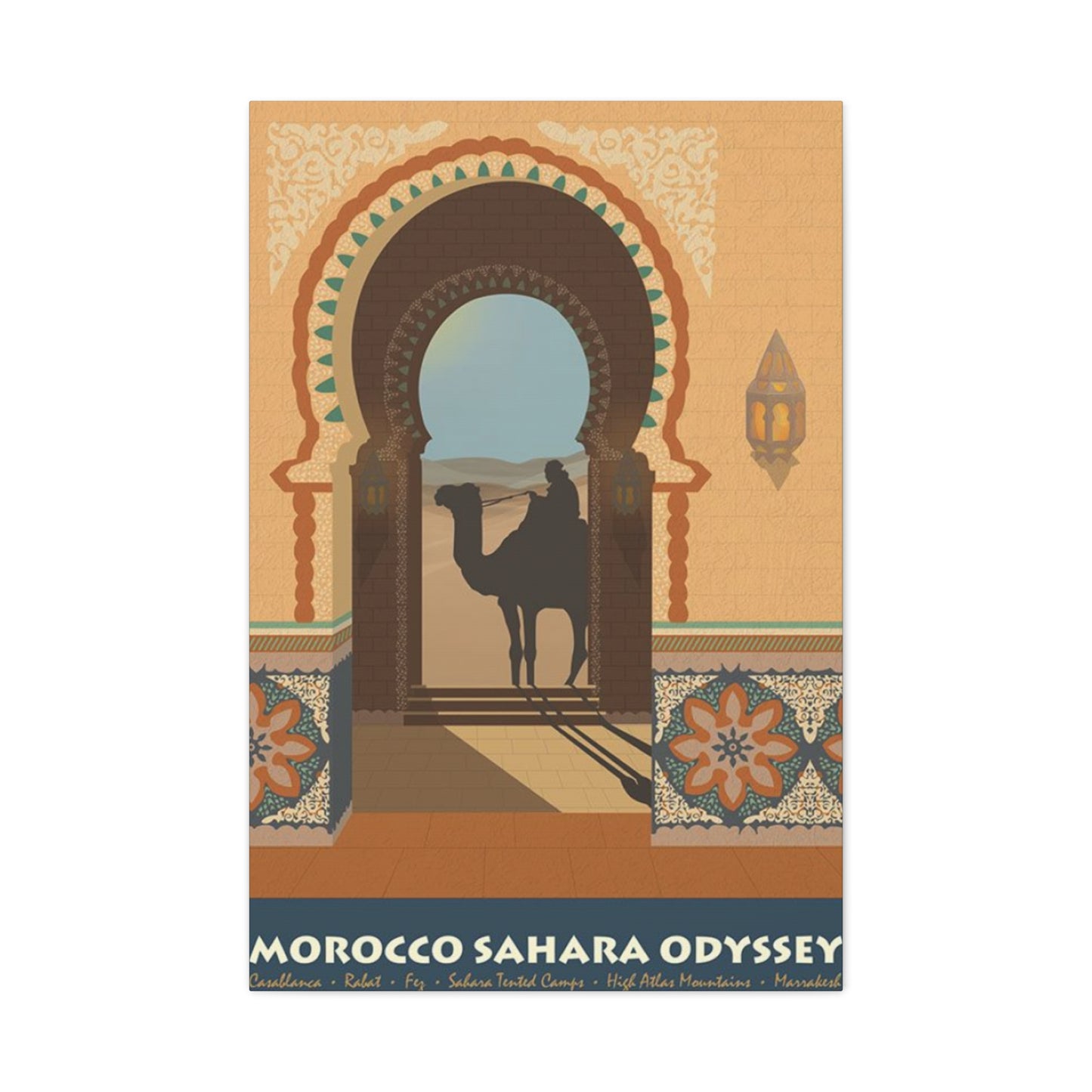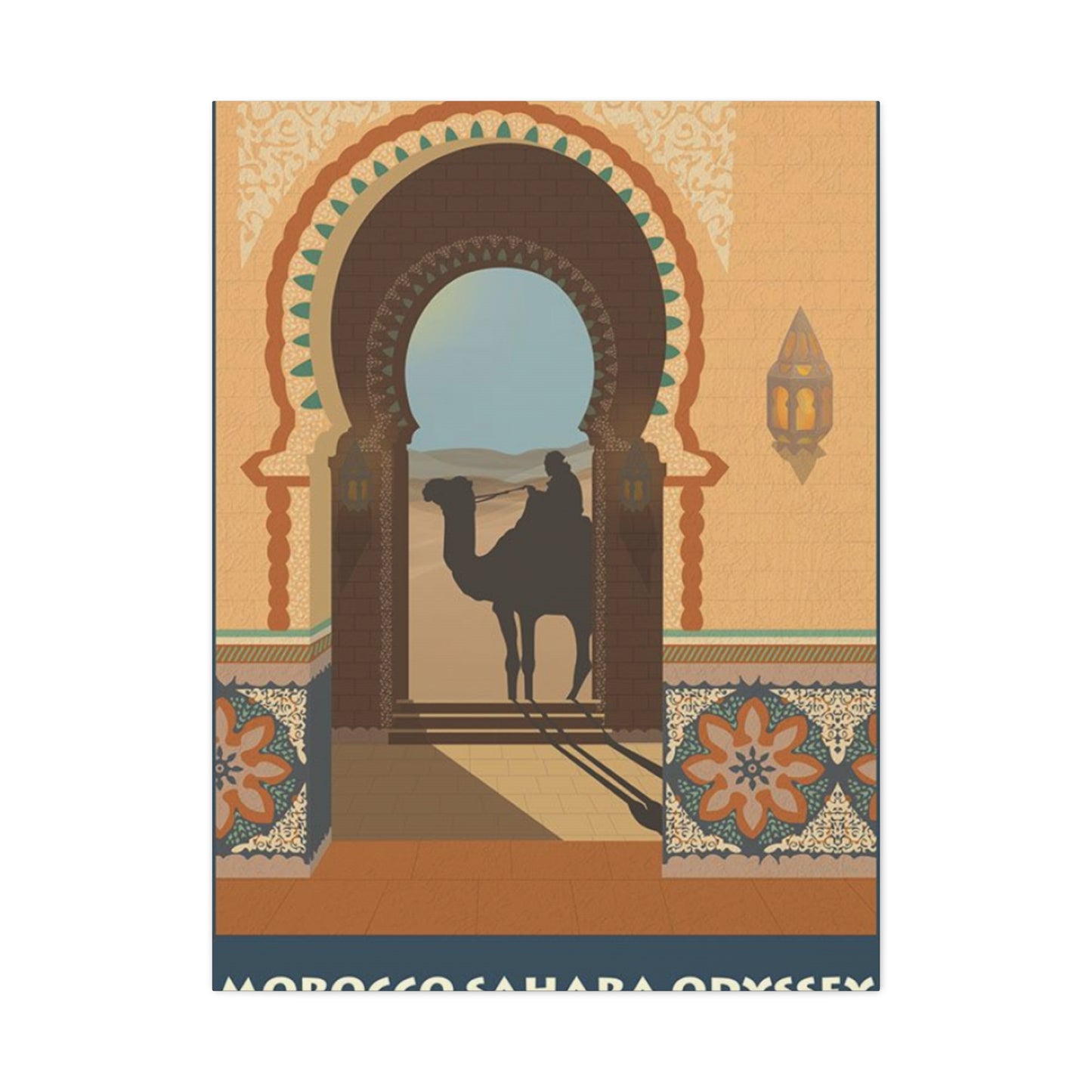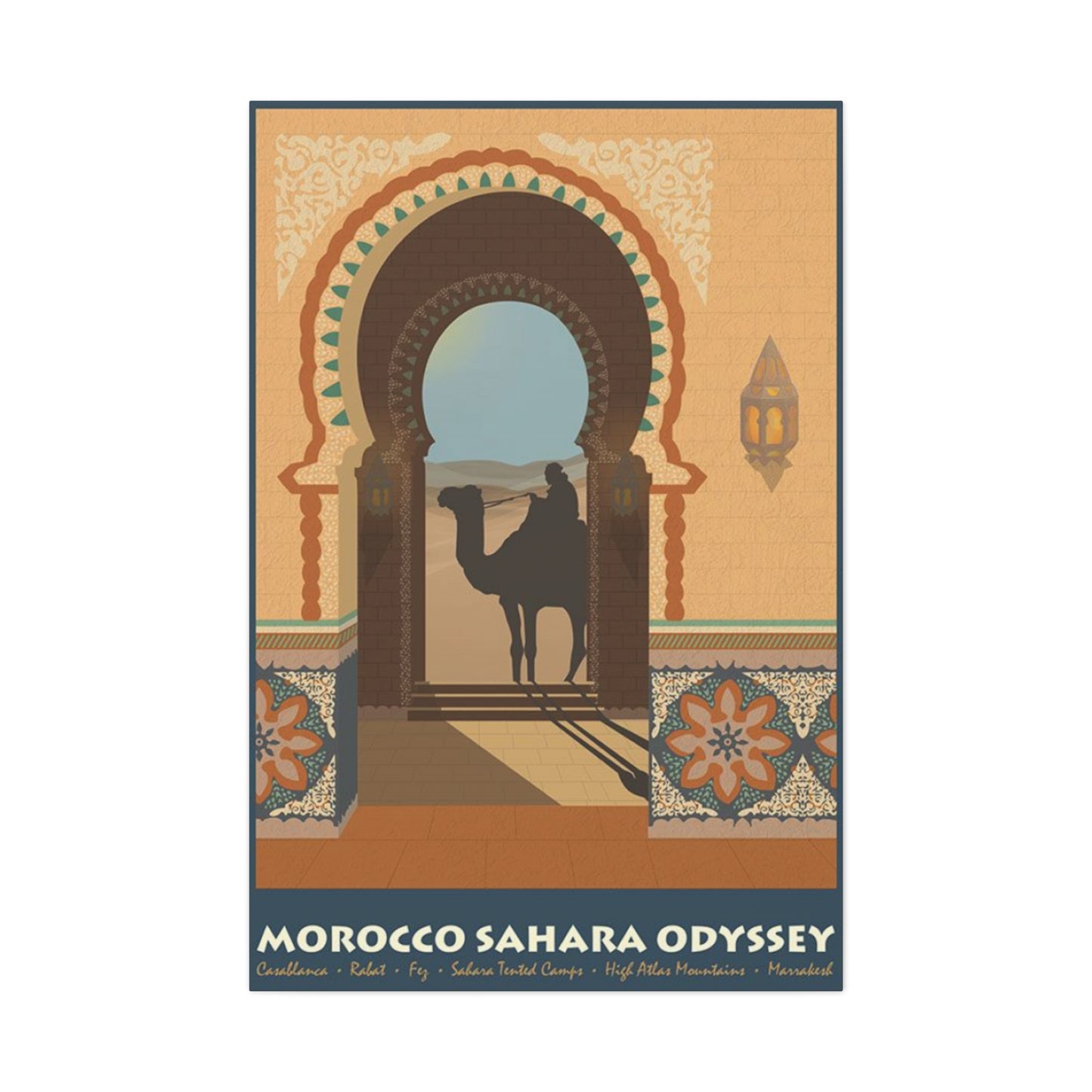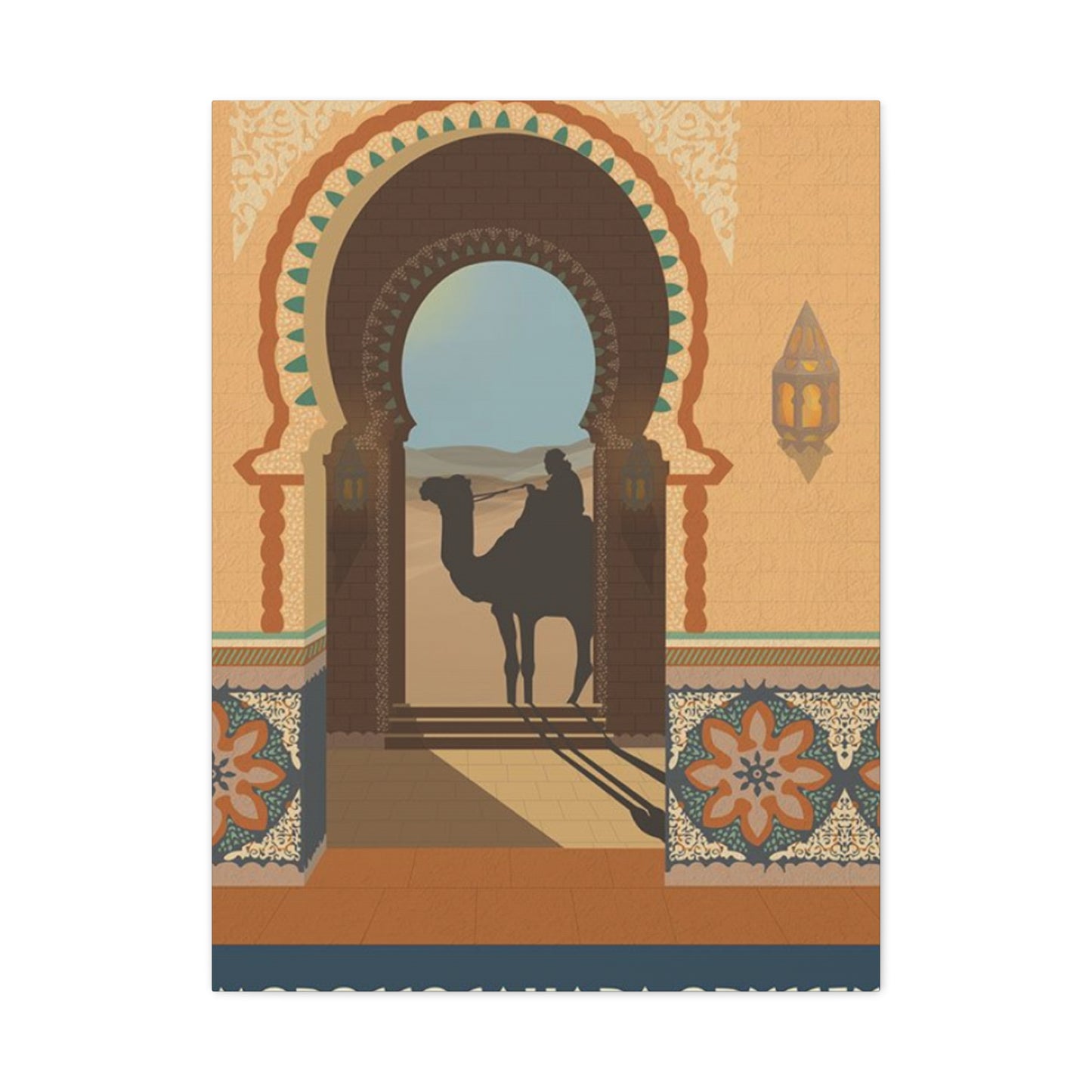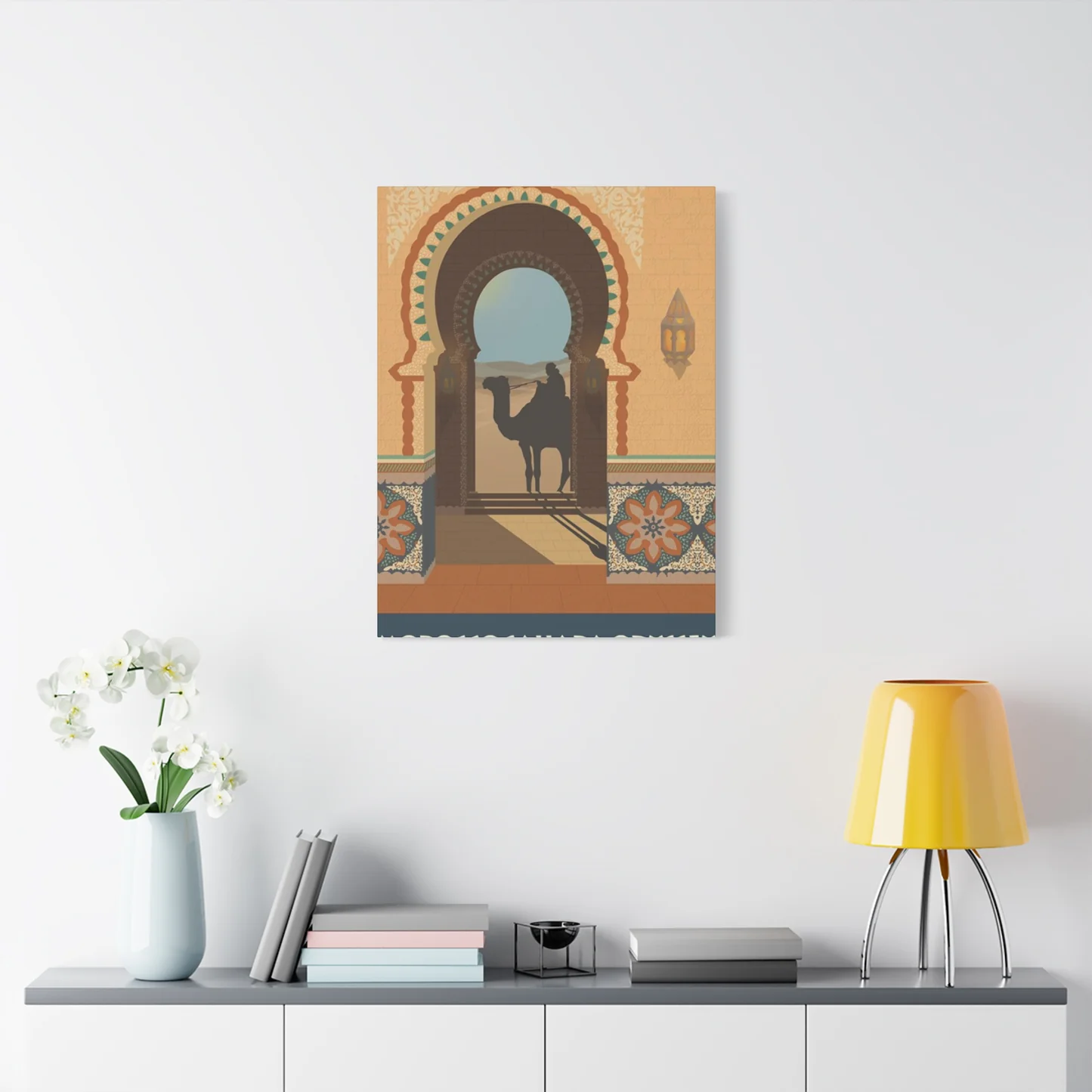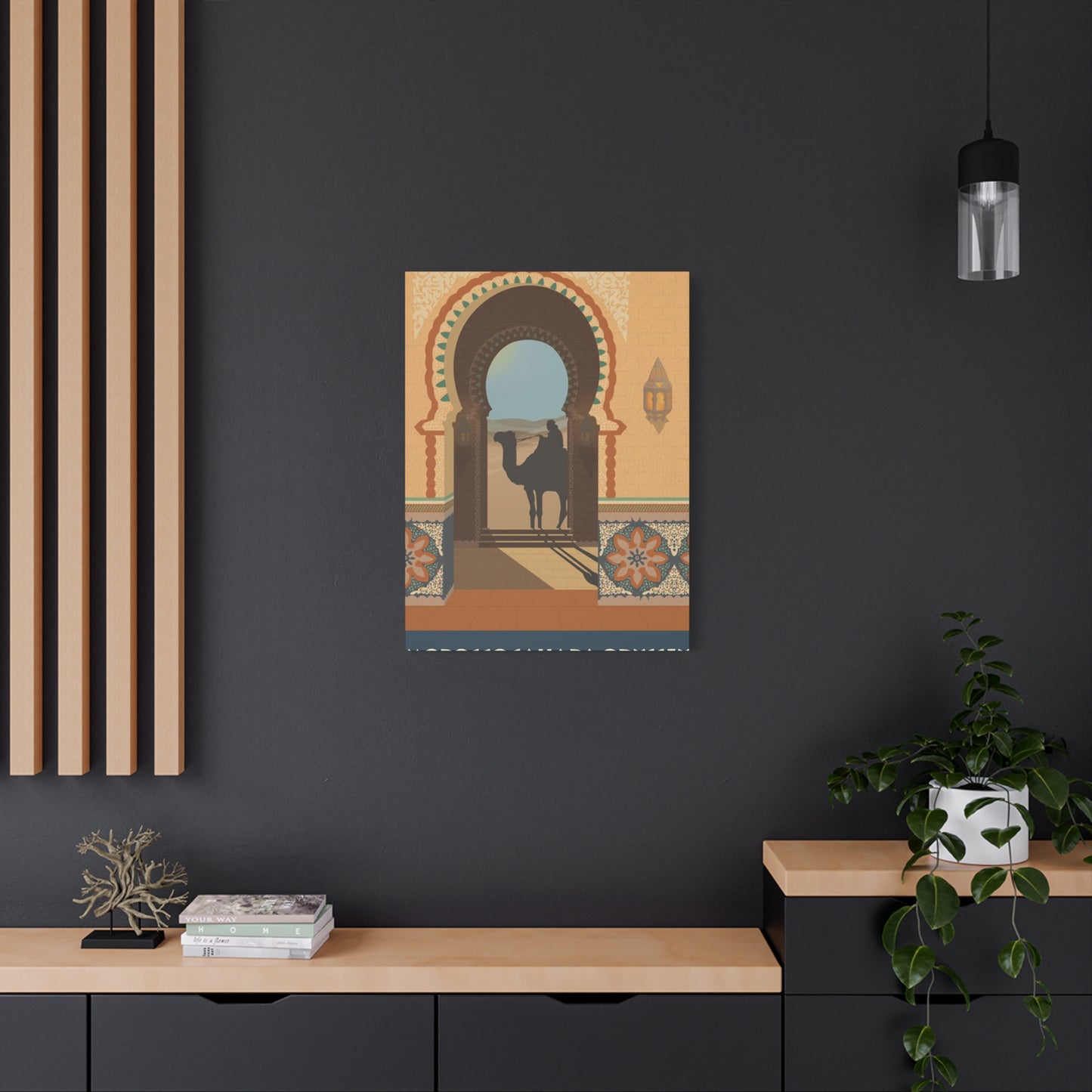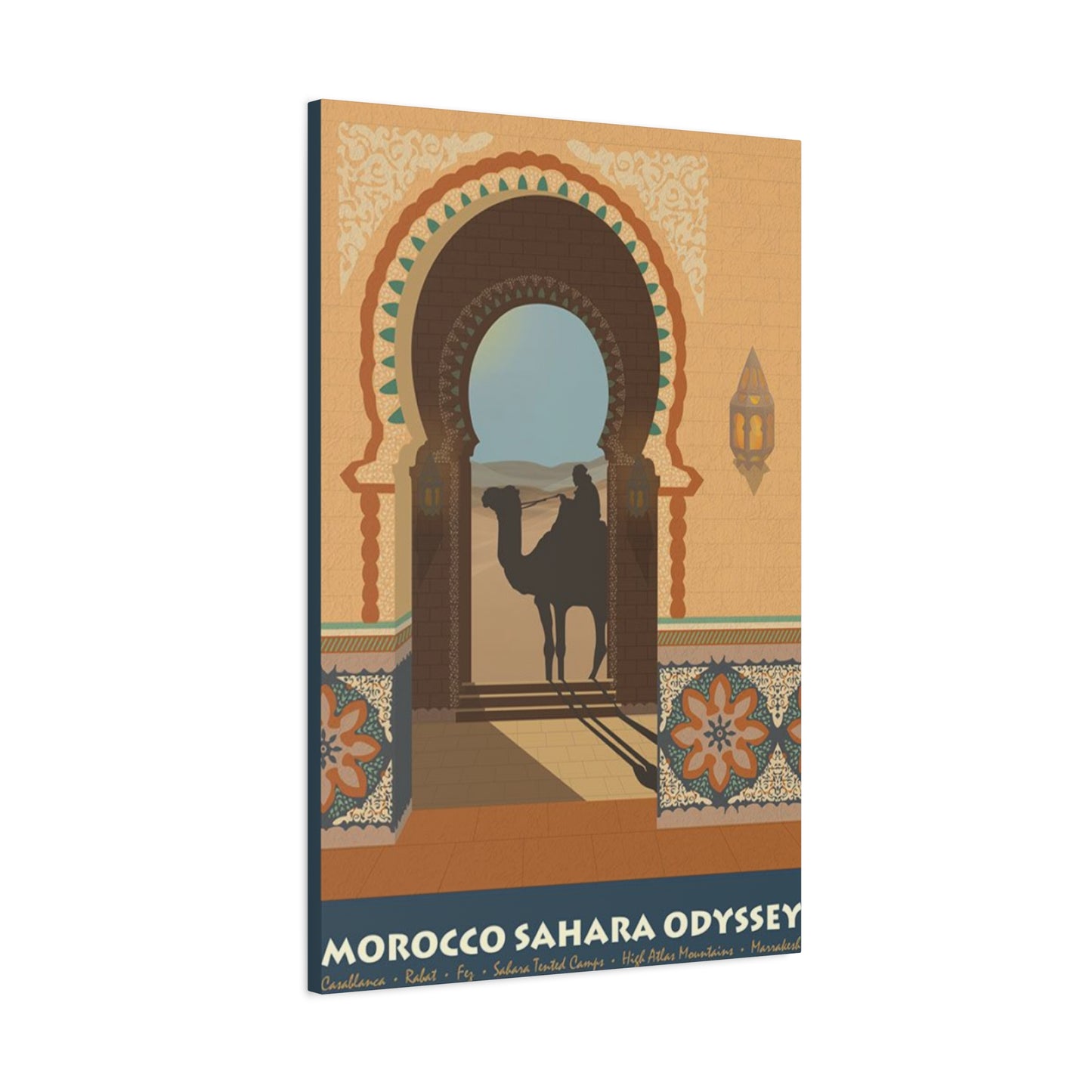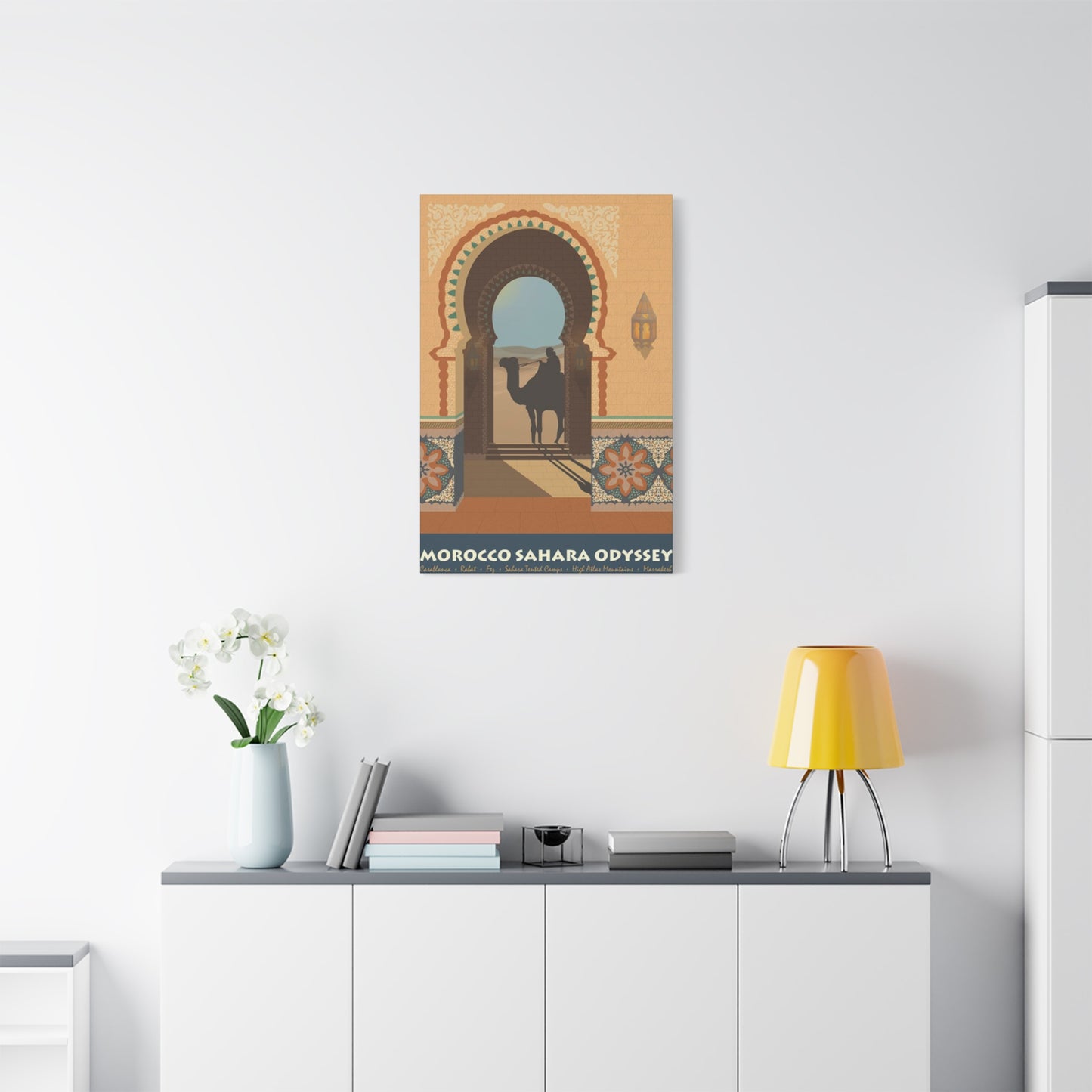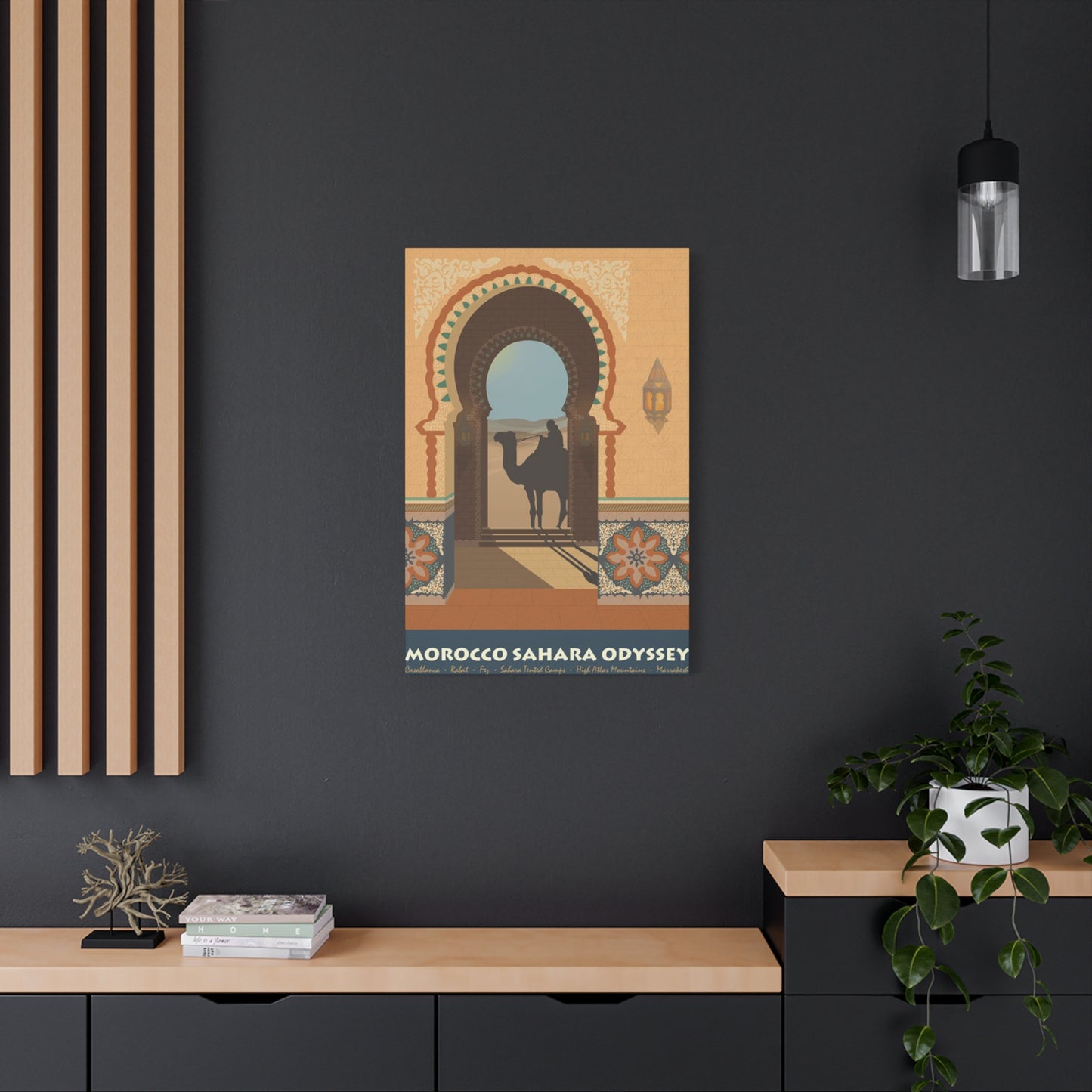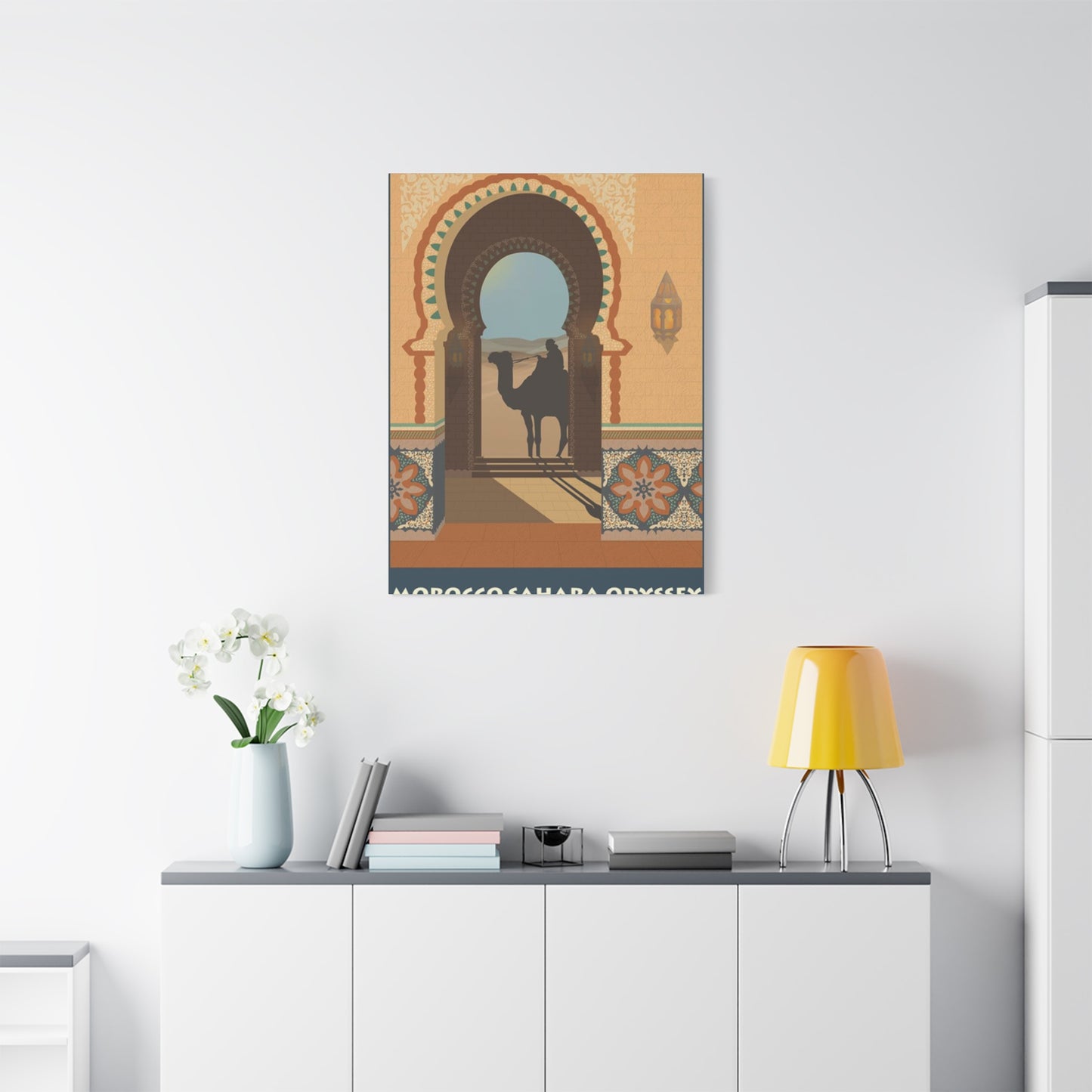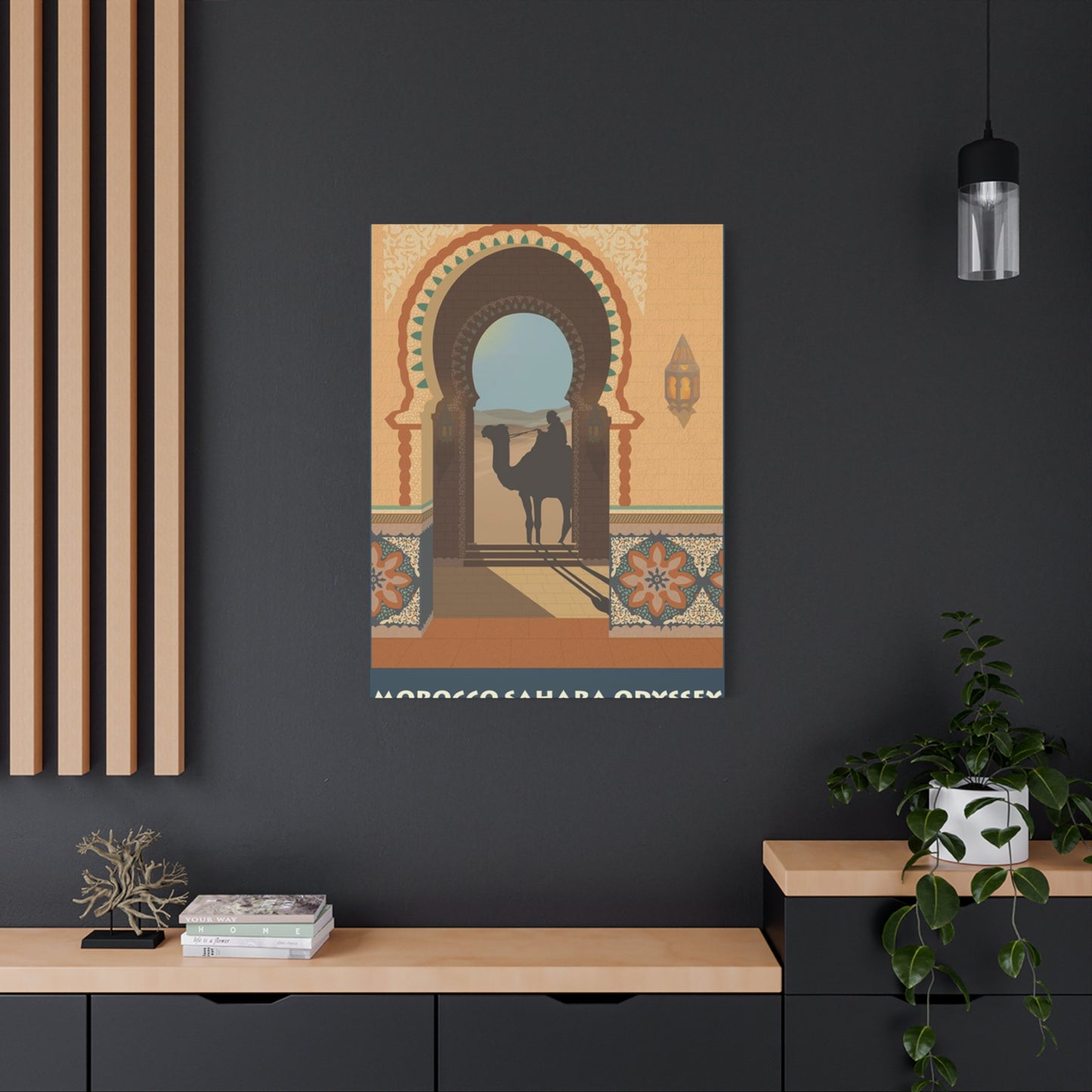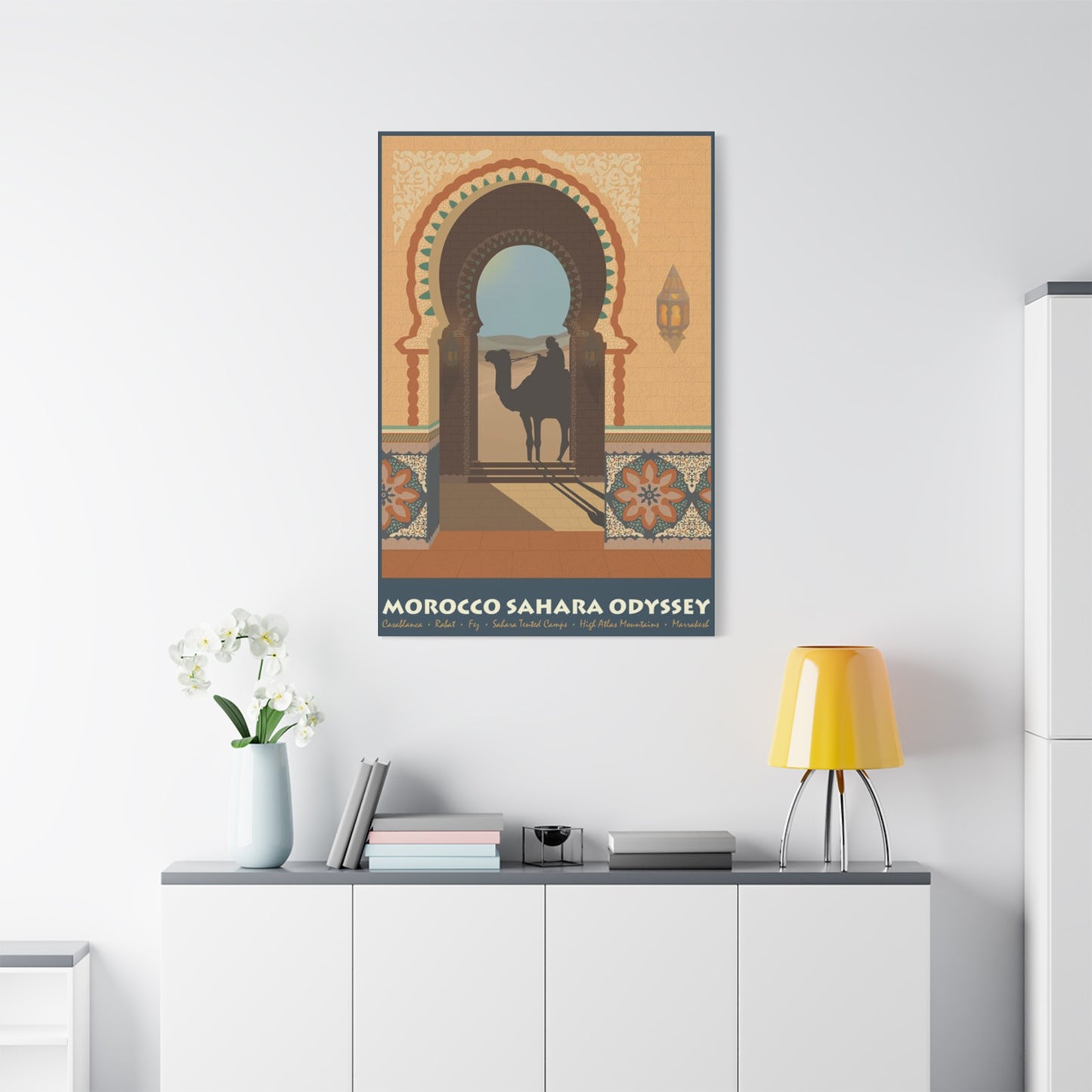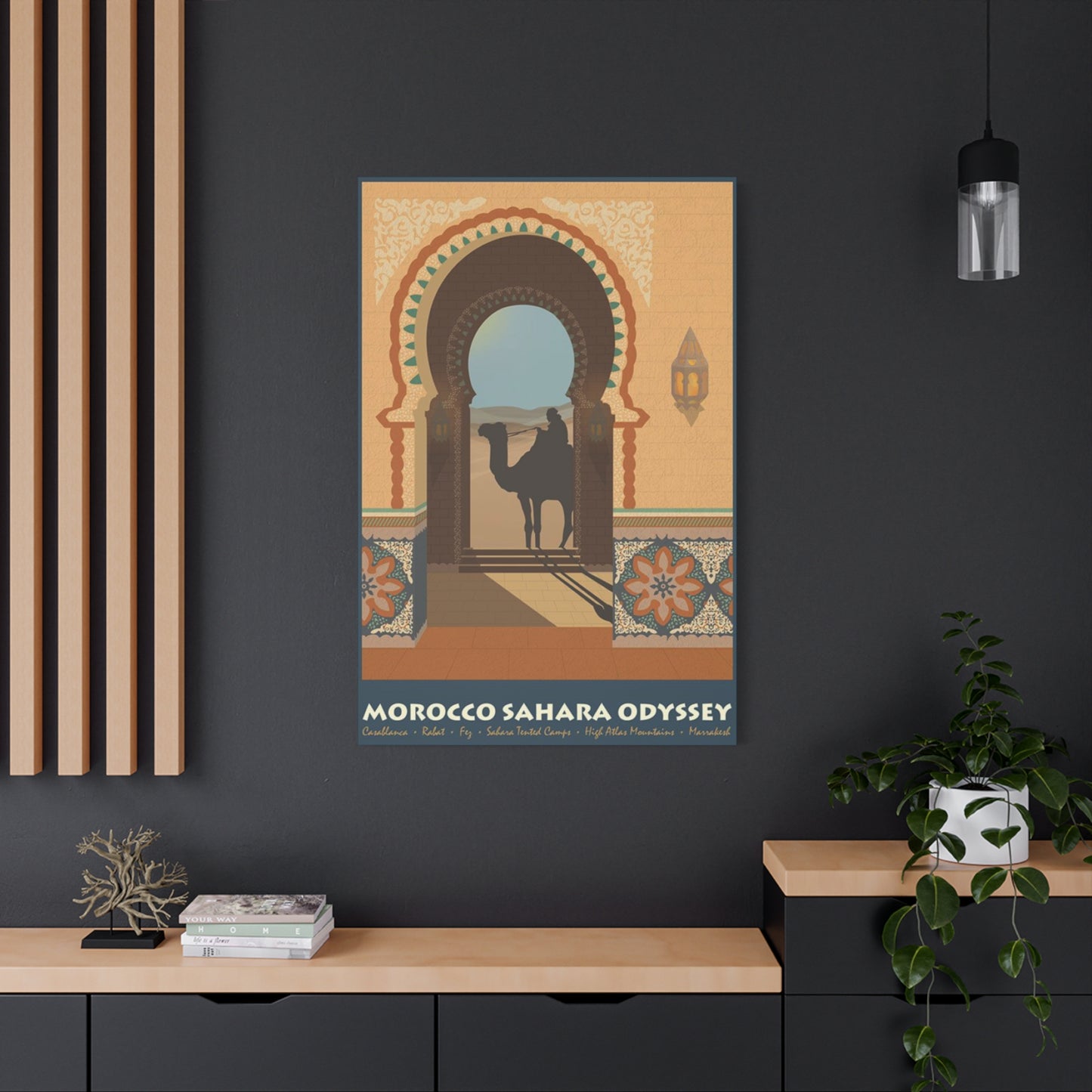Architectural Moroccan Wall Art: Bringing North African Elegance Into Your Living Space
The allure of North African design has captivated interior decorators and art enthusiasts worldwide, with its mesmerizing patterns, vibrant colors, and architectural sophistication creating an enchanting atmosphere in any room. Canvas prints featuring the distinctive architectural elements from this region offer homeowners an opportunity to infuse their spaces with exotic charm while maintaining contemporary aesthetics. These artistic representations serve not merely as decorative pieces but as windows into a rich cultural heritage that spans centuries of craftsmanship and artistic innovation.
The fascination with these architectural motifs stems from their ability to transform ordinary walls into captivating focal points that spark conversation and admiration. Each piece tells a story of ancient craftsmanship, blending geometric precision with organic flow, creating visual harmony that resonates with modern design sensibilities. Whether adorning a minimalist living room or complementing a maximalist bohemian bedroom, these canvas artworks bridge the gap between traditional aesthetics and contemporary interior design trends.
Canvas Prints Featuring North African Architectural Windows
The artistic representation of architectural openings from North Africa on canvas creates an immediate connection between viewers and the mystical landscapes of this enchanting region. These prints capture the essence of centuries-old building techniques, showcasing the intricate details that make each architectural element unique. The canvas medium proves particularly suitable for reproducing these designs, as it allows for rich color reproduction and texture that brings depth to the geometric patterns and ornamental details characteristic of this style.
When selecting pieces that feature these architectural elements, consider how the color palette interacts with your existing décor. Many prints showcase the traditional blue and white combinations that evoke the coastal cities of North Africa, while others display earthy terracotta tones that reflect the desert landscapes. The versatility of these artworks allows them to complement various interior design schemes, from coastal themes to desert-inspired aesthetics, and even modern industrial settings where the contrast creates visual interest.
The dimensional quality of canvas printing enhances the architectural features depicted in these artworks. Unlike paper prints, canvas provides a subtle texture that mimics the tactile nature of the actual structures, creating a more immersive visual experience. This textured surface catches light differently throughout the day, revealing new details and creating dynamic shadows that add life to the artwork. Gallery-wrapped canvases, where the image extends around the edges, eliminate the need for framing and create a contemporary presentation that allows the artwork to float elegantly on your wall.
Interior designers frequently recommend these prints for creating statement walls in various rooms. In dining areas, they establish an exotic ambiance that enhances the dining experience, while in bedrooms, they create a serene, contemplative atmosphere conducive to relaxation. Home offices benefit from the geometric precision and symmetry of these designs, which can promote focus and creativity. The key to successful placement lies in considering the scale of the artwork relative to your wall space and furniture arrangement.
The production quality of canvas prints significantly impacts their longevity and visual appeal. Premium canvases utilize fade-resistant inks that maintain color vibrancy for years, even in rooms with substantial natural light exposure. The canvas material itself should be thick enough to prevent sagging over time while remaining flexible enough to wrap smoothly around the frame. Many manufacturers now offer eco-friendly canvas options made from sustainable materials, appealing to environmentally conscious consumers who want beautiful art without compromising their values.
Collectors appreciate these prints for their accessibility compared to original artworks while still maintaining artistic integrity. Limited edition prints, numbered and signed by artists, offer a middle ground between mass-produced décor and expensive original paintings. These editions often appreciate in value over time, making them not just decorative purchases but potential investments. Documentation of authenticity and proper storage of certificates ensures the piece maintains its provenance and value.
Traditional Architectural Elements in Wall Décor Prints
The incorporation of traditional architectural elements into modern wall décor represents a beautiful marriage of past and present. These prints preserve ancient design principles while presenting them in a format that suits contemporary living spaces. The architectural openings characteristic of North African buildings feature distinctive horseshoe arches, intricate latticework, and geometric tile patterns that have influenced design movements worldwide. By bringing these elements into your home through wall art, you create a connection to a rich architectural tradition that values beauty, symmetry, and spiritual significance.
Traditional designs from this region emphasize the interplay between light and shadow, a concept that translates beautifully to canvas prints. The latticework patterns, known for filtering harsh sunlight while creating mesmerizing shadow patterns, become artistic subjects themselves when captured in photographs or illustrations. These prints often showcase how architectural elements serve both functional and aesthetic purposes, demonstrating the ingenuity of builders who created structures that remained cool in scorching heat while dazzling the eye with their beauty.
The color symbolism embedded in traditional architecture adds layers of meaning to these decorative prints. Blues represent protection and spirituality, greens symbolize paradise and renewal, while ochre and terracotta tones connect to the earth and stability. Understanding these color associations can help you select artwork that not only looks beautiful but also carries the symbolic weight you desire for your space. This depth of meaning elevates these prints beyond mere decoration, making them meaningful additions to your home.
Architectural proportions in these designs follow mathematical principles that create inherent visual harmony. The golden ratio appears frequently in the dimensions of archways and the spacing of decorative elements, creating compositions that feel naturally balanced to the human eye. When these proportions are faithfully reproduced in canvas prints, they bring that same sense of harmony to your walls. This mathematical precision explains why these designs remain timeless, transcending fleeting trends to offer enduring aesthetic appeal.
Regional variations within North African architecture provide diverse options for collectors. Coastal influences bring nautical elements and lighter color palettes, while inland desert regions feature earthier tones and more robust structural elements. Mountain communities developed their own distinctive styles adapted to cooler climates and different available materials. Canvas prints capturing these regional differences allow you to select artwork that resonates with your personal preferences and the specific atmosphere you wish to create in your home.
The preservation of architectural heritage through artistic reproduction serves an important cultural function. As modernization transforms cities and traditional buildings face the threat of demolition, these prints help maintain visual records of architectural treasures. By displaying such artwork, homeowners participate in cultural preservation, keeping these designs alive in collective memory and inspiring appreciation for traditional craftsmanship among new generations.
Exotic Canvas Artwork Celebrating North African Design
Exotic appeal defines the category of canvas artwork that celebrates the distinctive design elements originating from North Africa. These pieces transport viewers to distant lands, evoking the mystery and romance associated with ancient cities, bustling souks, and tranquil courtyards. The exotic quality stems not from otherness but from the unfamiliar beauty that challenges conventional Western design norms, offering fresh perspectives on color combinations, spatial arrangements, and decorative approaches.
The allure of exotic artwork lies in its ability to transform familiar spaces into extraordinary environments. A well-chosen canvas print featuring architectural elements can serve as the cornerstone of an entire room's design scheme, inspiring furniture selections, textile choices, and accessory decisions. This transformative power makes these pieces particularly valuable for homeowners looking to refresh their interiors without undertaking extensive renovations. Simply adding one or two strategically placed canvas prints can completely change a room's character and emotional resonance.
Layering exotic artwork with complementary decorative elements amplifies its impact. Pairing canvas prints with textiles featuring similar geometric patterns creates visual cohesion, while contrasting them with simpler, solid-colored furnishings allows the artwork to stand out as the focal point. Metal lanterns, ceramic vessels, and woven baskets inspired by North African crafts enhance the exotic atmosphere without overwhelming the space. The key lies in achieving balance between thematic elements and maintaining enough restraint to prevent the room from feeling like a themed restaurant.
The psychological impact of exotic artwork should not be underestimated. These pieces can evoke wanderlust, inspire creativity, and create emotional connections to places you may have visited or dream of exploring. Travel enthusiasts often use such artwork to commemorate journeys, selecting pieces that remind them of specific cities or experiences. Even those who have never visited the region can benefit from the emotional and aesthetic qualities these prints bring to their homes, enjoying the beauty without the passport.
Seasonal rotation of canvas artwork allows you to refresh your space throughout the year. Lighter, cooler-toned pieces featuring coastal architectural elements work wonderfully during summer months, while warmer, earthy tones suit autumn and winter seasons. This rotation keeps your interior feeling current and dynamic without requiring permanent changes or significant expense. Storage of canvas prints requires climate-controlled conditions to prevent warping or damage, but proper care ensures pieces remain in excellent condition for decades.
The growing appreciation for global design influences has made exotic artwork increasingly mainstream. Interior design magazines regularly feature rooms incorporating elements from various world cultures, demonstrating how these pieces integrate successfully into diverse design schemes. This mainstream acceptance means homeowners can embrace exotic artwork without fear of their choices appearing outdated or overly niche. The key lies in selecting quality pieces that genuinely appeal to your aesthetic sensibilities rather than following trends blindly.
Archway Designs on Canvas for Wall Decoration
Archway designs represent some of the most recognizable and beloved architectural elements from North African design traditions. These graceful curves and dramatic forms create instant visual interest, drawing the eye upward and adding perceived height to any room. Canvas prints featuring archway designs capture the majestic quality of these structural elements while offering the flexibility to display them in spaces where actual architectural modifications would be impractical or impossible.
The horseshoe arch, distinctively associated with this architectural tradition, possesses a unique aesthetic that sets it apart from Roman or Gothic arches. Its extended curve creates a sense of embrace, symbolically welcoming viewers into protected spaces. When this form appears in canvas artwork, it maintains that welcoming quality while serving as a striking design element. The symmetry of archways naturally draws attention to whatever occupies the space beneath or beyond them in the composition, creating built-in focal points within the artwork itself.
Architectural archways in these prints often frame additional visual elements, creating layered compositions that reward extended viewing. Through one arch, you might glimpse a courtyard fountain; through another, a distant mountain range or cityscape. This layering technique adds depth to two-dimensional artwork, creating the illusion of three-dimensional space that invites viewers to imaginatively step through the canvas into the scene beyond. This spatial quality makes archway prints particularly effective for creating the impression of expanded space in smaller rooms.
The decorative elements surrounding archways provide abundant visual interest and demonstrate the extraordinary craftsmanship of traditional artisans. Tile work in geometric patterns often frames these openings, with each tile precisely cut and placed to create intricate designs. Carved plasterwork adds three-dimensional texture, casting shadows that change with the light throughout the day. Canvas prints that capture these details preserve the legacy of craftspeople whose skills required years of apprenticeship to master, honoring their artistry while making it accessible to contemporary audiences.
Color choices in archway canvas prints significantly influence their emotional impact and compatibility with various décor styles. Monochromatic prints featuring black and white or sepia tones emphasize form and shadow, creating dramatic, sophisticated statements suitable for modern or minimalist interiors. Full-color reproductions celebrate the vibrant palette traditional to the region, with bold blues, rich reds, and gleaming golds creating energetic, joyful atmospheres. Understanding your room's existing color scheme helps guide selection toward prints that enhance rather than clash with your established palette.
Scale considerations prove particularly important when selecting archway canvas prints. Oversized prints featuring a single grand archway create bold statements suitable for large walls or open-concept spaces where they won't overwhelm. Smaller prints or those featuring multiple archways work better in more intimate settings or grouped as part of gallery wall arrangements. The architectural nature of these subjects means they naturally suit vertical orientations, making them ideal for narrow wall spaces that challenge decorators searching for appropriately proportioned artwork.
Intricate Canvas Prints Showcasing Detailed Architectural Patterns
Intricate patterns define much of North African architectural decoration, with geometric designs that mesmerize viewers through their complexity and mathematical precision. Canvas prints showcasing these detailed patterns bring this intricacy into homes, offering daily opportunities to discover new details and appreciate the artistic sophistication of traditional designers. The meditative quality of examining these patterns provides unexpected benefits, offering visual interest that can calm anxious minds and provide gentle focus points during stressful periods.
The creation of these intricate patterns follows ancient principles of sacred geometry, where specific proportions and shapes hold spiritual significance. Stars, polygons, and interlocking shapes repeat and rotate to create infinite-seeming patterns that symbolize the eternal nature of creation. While modern viewers may not consciously recognize these spiritual dimensions, the mathematical harmony inherent in these designs creates subconscious appeal that explains their enduring popularity across cultures and centuries.
Reproducing intricate patterns on canvas requires advanced printing technology capable of maintaining clarity and precision at high resolutions. Lower-quality printing processes blur fine lines or lose detail in complex areas, diminishing the impact of the artwork. Premium canvas prints utilize professional-grade printers with numerous ink colors, allowing faithful reproduction of even the most complex patterns. When evaluating potential purchases, examine detail areas closely, either in person or through high-resolution images online, to ensure the printing quality meets professional standards.
The versatility of pattern-focused canvas prints allows them to integrate into various design contexts beyond obviously themed rooms. In contemporary settings, these geometric patterns complement modern furniture with clean lines and minimal ornamentation. In traditional or eclectic spaces, they add layers of visual texture without introducing competing stylistic elements. This adaptability makes pattern-focused prints particularly valuable for homeowners who appreciate the aesthetic qualities of these designs without necessarily wanting their entire space to reflect a specific cultural theme.
Combining multiple canvas prints featuring complementary patterns creates dynamic wall displays with significant visual impact. When selecting pieces for grouping, consider how colors and pattern scales interact. Mixing large-scale, bold patterns with smaller, more delicate designs creates contrast and prevents visual monotony. Maintaining consistent color palettes across grouped pieces ensures cohesion while allowing each artwork to contribute unique visual elements. The arrangement itself deserves careful planning, with balanced spacing and thoughtful positioning creating professional-looking results.
Educational value accompanies the aesthetic appeal of intricate pattern prints. These artworks provide springboards for learning about mathematics, geometry, cultural history, and artistic techniques. Families with children might use these prints as conversation starters about different cultures, mathematical concepts, or the importance of patience and precision in craftsmanship. This educational dimension adds depth to the artwork's value, making it an investment in knowledge as well as beauty.
North African Architectural Elements in Canvas Wall Artwork
North African architectural elements encompass a diverse range of features beyond just archways and patterns, including courtyards, fountains, rooflines, and decorative details that collectively create the distinctive character of buildings from this region. Canvas wall artwork capturing these varied elements offers collectors opportunities to explore different aspects of the architectural tradition, building comprehensive visual narratives about place, culture, and aesthetic philosophy through carefully curated collections.
Courtyard scenes depicted on canvas bring the peaceful atmosphere of private outdoor spaces into homes where such luxuries might not exist. Traditional architecture in this region emphasizes interior courtyards as family gathering places, protected from public view while open to the sky. Canvas prints featuring these spaces often showcase central fountains, potted plants, and shaded seating areas that invite viewers to imagine themselves in these serene settings. The horizontal composition of many courtyard scenes makes them ideal for placement above sofas or console tables where they complement furniture proportions.
Roofline silhouettes against dramatic skies create striking graphic compositions that work particularly well in modern interiors. The stepped profiles of traditional buildings, punctuated by chimneys and roof terraces, create distinctive skylines that photographers and artists find endlessly fascinating. Canvas prints capturing these rooflines at sunrise or sunset gain additional drama from atmospheric lighting, with warm or cool color temperatures establishing different moods. These prints often require minimal additional decoration, as their bold forms and dramatic lighting create self-contained artistic statements.
Doorway compositions offer another popular subject for canvas artwork, featuring elaborately decorated entrances that serve as both functional openings and symbolic thresholds. Traditional beliefs about doorways as boundaries between public and private realms, secular and sacred spaces, invested their decoration with special significance. Heavy wooden doors studded with metal fixtures, surrounded by carved plaster or intricate tilework, demonstrate the importance placed on these transitional spaces. Canvas prints featuring these elements bring symbolic depth to your home while providing gorgeous decorative focal points.
Decorative screens and grillwork, serving both ventilated privacy and aesthetic purposes in traditional architecture, translate beautifully to canvas artwork. These elements create fascinating plays of positive and negative space, with cut-out patterns allowing light passage while obscuring detailed views. Photographed against bright backgrounds, these screens create dramatic silhouettes that emphasize their geometric patterns. When reproduced on canvas, these images bring architectural sophistication and visual interest to walls while maintaining relative simplicity that prevents visual overwhelm.
Water features appear frequently in canvas artwork celebrating North African architecture, reflecting the precious nature of water in predominantly arid climates. Fountains, reflecting pools, and elaborate channels demonstrate both practical water management and aesthetic appreciation. The sound and sight of water provided both physical cooling and psychological refreshment in hot climates, making these features central to architectural planning. Canvas prints featuring water elements bring this refreshing quality to your space symbolically, creating associations with coolness and tranquility even without actual water present.
Elegant Decorative Canvas Prints with Distinctive Design Features
Elegance in canvas prints featuring North African architectural elements emerges from the harmonious combination of complex patterns, refined color palettes, and balanced compositions. These prints avoid the garishness sometimes associated with exotic décor, instead offering sophisticated interpretations that appeal to refined aesthetic sensibilities. The elegance stems partly from the original architecture itself, created during periods when beauty was considered essential rather than optional, and when master craftspeople dedicated careers to perfecting their techniques.
The selection of elegant prints requires discernment regarding color saturation, composition, and reproduction quality. Overly saturated colors can appear garish and cheap, while carefully calibrated hues maintain visual interest without overwhelming. Compositions with balanced elements, where no single feature dominates inappropriately, create the visual equilibrium associated with elegance. Reproduction quality affects perceived elegance significantly, as poor printing introduces artifacts, banding, or muddy colors that undermine the sophistication of the original subject matter.
Monochromatic and limited color palette prints often convey particular elegance, allowing form, texture, and composition to take precedence over chromatic excitement. Black and white photography of architectural elements emphasizes contrasts, shadows, and structural details that color sometimes obscures. These restrained presentations suit formal spaces and complement traditional décor schemes where colorful artwork might clash with existing palettes. The timeless quality of monochromatic artwork also ensures it remains stylistically current regardless of shifting color trends in interior design.
The framing and presentation of canvas prints significantly influences their perceived elegance. Gallery-wrapped canvases that extend the image around the edges create sleek, modern presentations that eliminate the visual interruption of frames. For traditional settings, floating frames in coordinating finishes add polish without overwhelming the artwork itself. The decision between framed and unframed presentations depends largely on your overall décor aesthetic and the specific artwork in question, with some pieces benefiting from frames while others look best unadorned.
Placement strategies for elegant artwork require consideration of surrounding elements and viewing angles. Artwork positioned at appropriate heights relative to furniture and human eye levels appears intentional and professionally curated. Adequate surrounding wall space prevents the crowded appearance that diminishes elegance, allowing each piece room to breathe and command attention appropriately. Lighting significantly affects elegant presentations, with dedicated picture lights or strategically positioned spotlights highlighting artwork while creating ambient sophistication.
The cultural sophistication these prints represent adds to their elegant appeal. Unlike mass-produced generic artwork, these pieces reference specific architectural traditions with deep historical roots and continuing cultural significance. This cultural weight provides substance that elevates them beyond mere decoration, making them conversation pieces that reveal the owner's appreciation for global arts and humanities. This intellectual dimension of elegance proves as important as visual aesthetics, creating artwork that engages minds as well as eyes.
Arabesque Design Elements on Canvas Décor
Arabesque patterns represent one of the most distinctive decorative traditions in North African and broader Islamic art, characterized by interlocking vegetal motifs that flow in seemingly endless rhythms across surfaces. Canvas décor featuring these designs brings organic movement and sophisticated ornamentation to walls, creating visual interest through curves, tendrils, and flowing lines that contrast beautifully with the straight edges and right angles dominating most architectural spaces. The organic nature of these patterns creates softer, more welcoming atmospheres compared to purely geometric designs.
The philosophical underpinnings of arabesque design reflect theological principles about the infinite nature of creation and the unity of all existence. Individual elements connect and flow into one another without clear beginnings or endings, symbolizing continuity and interconnection. While contemporary viewers may not consciously recognize these spiritual dimensions, the patterns possess inherent appeal that transcends specific religious contexts, speaking to universal human appreciation for natural forms and organic growth patterns.
Arabesque canvas artwork varies considerably in complexity and density, from relatively simple, open designs with substantial background space to intricate, all-over patterns that cover entire surfaces. Simple arabesque designs work well in minimalist or modern settings where they provide organic interest without overwhelming clean aesthetics. Dense, complex patterns create richer, more traditional atmospheres suitable for maximalist approaches or rooms where visual excitement and energy are desired. Understanding your space's character and your personal preferences regarding visual density helps guide appropriate selections.
Color applications in arabesque canvas prints range from monochromatic to vibrantly polychromatic, each approach creating different aesthetic effects. Single-color designs emphasize form and flow, allowing viewers to focus on the graceful curves and connections between elements. Multi-color applications highlight different pattern layers or emphasize specific motifs within the overall design. Gold accents, traditional in many historical applications, add luxury and visual warmth, catching light and creating subtle sparkle that enlivens the artwork throughout the day.
The combination of arabesque patterns with architectural elements creates particularly compelling canvas artwork. An archway surrounded by arabesque decoration, or carved screens featuring these flowing patterns, demonstrates how different decorative approaches complement one another in traditional architecture. These combination pieces offer complexity and variety that sustain interest over time, providing new details to discover with each viewing. The interplay between geometric architectural forms and organic arabesque patterns creates dynamic tension that energizes compositions.
Arabesque designs possess remarkable adaptability to different formats and scales. Small canvas prints featuring detailed sections of larger patterns work beautifully in intimate spaces or as parts of gallery wall arrangements. Large-scale pieces showcasing expansive pattern fields create bold statements suitable for feature walls in living areas or lobbies. The scalability of these designs without loss of visual coherence demonstrates the mathematical sophistication underlying their apparently organic character, where proportional relationships maintain harmony regardless of size.
Heritage and Cultural Legacy in Canvas Wall Prints
Heritage preservation represents an important function of canvas wall prints featuring architectural elements from North Africa, as these artworks maintain visual records of building traditions that face ongoing threats from modernization, urban development, and changing construction practices. By displaying these prints, homeowners participate in cultural preservation efforts, keeping these design traditions alive in public consciousness while supporting artists and photographers who document architectural heritage. This preservation function adds meaningful dimension to aesthetic enjoyment, transforming décor choices into acts of cultural stewardship.
The cultural legacy embedded in these architectural designs reflects centuries of accumulated knowledge about materials, climate adaptation, aesthetic principles, and symbolic meaning. Master builders developed sophisticated techniques for creating structures that remained comfortable in extreme heat, used local materials efficiently, and incorporated beauty as an essential rather than optional element. Canvas prints preserving images of these buildings honor that accumulated wisdom while making it accessible to people worldwide who might never visit the actual structures.
Educational opportunities accompany heritage-focused canvas artwork, providing visual references for learning about history, culture, and architectural development. Families can use these prints as conversation starters about different ways of living, building, and organizing communities. Students of architecture, design, or history benefit from daily exposure to these examples of traditional building practices, subconsciously absorbing lessons about proportion, decoration, and functional beauty. This educational value extends the worth of these prints beyond mere decoration into the realm of informal learning tools.
The diversity within North African architectural traditions provides rich material for exploration through canvas artwork. Coastal cities developed styles influenced by Mediterranean trade connections, incorporating elements from various cultures while maintaining distinctive local character. Desert settlements adapted to harsh climates with thick walls, small openings, and internal courtyards. Mountain communities created robust structures to withstand cold winters and used local stone in characteristic ways. Canvas prints representing these regional variations create opportunities to explore geographic influences on architectural development.
Contemporary interpretations of heritage designs on canvas bridge historical and modern aesthetics, demonstrating how traditional elements remain relevant in current contexts. Artists and photographers might capture ancient buildings from unusual angles, emphasize abstract qualities of pattern and form, or juxtapose old and new architectural elements in single compositions. These contemporary approaches make heritage accessible to modern sensibilities, showing how historical designs continue inspiring current creativity rather than remaining frozen in the past.
The market for heritage canvas prints supports both preservation efforts and living artists working within traditional frameworks. Purchasing prints from photographers who document architectural heritage often directly supports preservation organizations or communities maintaining historic buildings. Similarly, buying work from contemporary artists practicing traditional decorative techniques helps sustain craft traditions that might otherwise disappear as younger generations pursue different careers. These economic connections add ethical dimensions to aesthetic choices, allowing conscious consumers to align purchasing decisions with their values.
Patterned Designs Highlighting Architectural Details
Patterned designs focusing on architectural details offer viewers opportunities to appreciate the extraordinary craftsmanship invested in traditional buildings from North Africa. These canvas prints often feature close-up views of tile work, carved plaster, painted woodwork, or other decorative elements that might escape notice when viewing entire structures. By isolating and enlarging these details, the artwork celebrates the skill of individual artisans while creating abstract compositions that work beautifully in contemporary interiors regardless of the viewer's knowledge about their architectural origins.
Tile patterns represent one of the most popular subjects for detailed architectural canvas prints, showcasing the geometric precision and color coordination that characterize traditional ceramic work. Each tile contributes to larger patterns that only become fully apparent when many tiles combine, demonstrating how individual elements serve greater design purposes. Close-up photography reveals the slight variations in individual tiles, evidence of handmade production that adds character absent from machine-made products. The glazed surfaces of tiles create subtle shine that photographers capture, adding dimensionality to flat canvas reproductions.
Carved plasterwork details demonstrate another aspect of traditional craftsmanship worthy of close examination. Artisans developed techniques for creating intricate three-dimensional patterns in plaster surfaces, with multiple layers of carving creating depth and shadow play. Canvas prints reproducing these details often emphasize the interplay of light and shadow across carved surfaces, creating dramatic contrasts that highlight the three-dimensional nature of the original work. Understanding that these patterns were often carved freehand, without modern measuring tools or computer guidance, deepens appreciation for the skill they represent.
Painted wooden elements, including ceiling panels, door surfaces, and screen frames, provide colorful subjects for detailed canvas prints. Traditional painters developed distinctive palettes and pattern vocabularies, creating decorated surfaces that complemented rather than competed with surrounding tile and plaster work. The aging of painted surfaces adds character through slightly faded colors and worn areas that reveal layers of history. Canvas prints capturing these weathered surfaces bring authentic character that perfectly aged new construction cannot replicate, offering visual interest through genuine patina.
Metal work details, including door hardware, grilles, and decorative fixtures, offer another category of architectural details suitable for canvas artwork. Traditional metalworkers created functional items with extraordinary decorative elaboration, demonstrating the cultural principle that everyday objects deserved beauty. Photographed close-up, metal work reveals textures, patinas, and construction techniques that showcase artisan skill. The contrast between strong structural metal and delicate decorative elements creates visual tension that translates well to canvas prints, offering both boldness and refinement simultaneously.
The abstract quality of many detailed architectural canvas prints allows them to function successfully in diverse interior contexts. Viewers unfamiliar with the architectural origins can appreciate these prints purely as abstract compositions with interesting colors, patterns, and textures. This dual nature as both representational and abstract art increases versatility, making these prints suitable for settings from traditional homes to cutting-edge contemporary spaces. The ambiguity about whether images represent architectural details or pure abstractions can itself become an interesting talking point during discussions about the artwork.
Majestic Compositions for Canvas Wall Decoration
Majesty in canvas wall decoration emerges from compositions that capture the grandeur and imposing beauty of significant architectural structures from North Africa. These prints often feature commanding viewpoints, dramatic lighting, and impressive scale that communicate the awe these buildings inspire when encountered in person. The majestic quality appeals to viewers seeking artwork that makes bold statements, creates focal points, and establishes impressive atmospheres in their spaces.
Monumental buildings photographed from ground level create particularly majestic impressions, with towering walls, massive doorways, and soaring arches emphasizing scale and inspiring appropriate humility. This upward perspective mimics human experience approaching these structures, creating psychological impact through size relationships. Canvas prints utilizing this perspective work especially well in rooms with high ceilings where the vertical emphasis complements architectural proportions. The sense of looking upward toward something greater naturally draws the eye and creates contemplative moods.
Dramatic lighting conditions significantly enhance the majestic quality of architectural canvas prints. Golden hour light, with warm tones and long shadows, creates romantic, glowing atmospheres that emphasize beauty and craft. Storm light, with dark skies contrasting against illuminated buildings, generates dramatic tension and highlights structural strength. Night photography showcasing artificially lit buildings against dark skies creates mysterious, enchanting effects that emphasize the magical quality of traditional architecture. Selecting prints with lighting that matches your desired emotional atmosphere helps ensure the artwork creates the intended impact.
Panoramic compositions capturing entire building complexes or city skylines communicate majesty through scope rather than just scale. These wide-format prints work beautifully above sofas, beds, or dining tables where their horizontal orientation complements furniture below. The sweeping views they provide create impressions of expansive space, making them particularly valuable in smaller rooms where they can visually expand boundaries. The complexity of cityscape compositions, with multiple buildings, various architectural details, and urban life indicators, provides abundant visual interest that sustains engagement over time.
The choice between color and monochromatic presentations affects majestic artwork differently. Full-color prints celebrate the vibrant hues traditional to the region, with their visual richness enhancing impressions of luxury and cultural vitality. Monochromatic prints, particularly those in dramatic black and white, emphasize form, structure, and contrasts, creating timeless gravitas that suits formal settings. Sepia tones add nostalgic historical dimensions, connecting contemporary viewers to the deep history these buildings represent. Understanding the emotional associations of different color approaches helps guide selections toward prints that achieve desired effects.
Majestic canvas artwork benefits from proportional placement and adequate surrounding space. Impressive artwork requires breathing room, with sufficient blank wall area around pieces preventing crowded appearances that diminish impact. Hanging height considerations prove particularly important, with eye-level placement ensuring comfortable viewing despite potentially large sizes. In rooms with multiple conversation areas, positioning majestic artwork where it's visible from various vantage points maximizes its impact and justifies the investment in significant pieces.
Architectural Heritage in Canvas Print Collections
Collecting canvas prints featuring architectural heritage from North Africa offers enthusiasts opportunities to develop curated displays that tell visual stories about places, periods, or particular building types. Thoughtful collecting goes beyond accumulating random images, instead developing coherent themes that create dialogue between pieces and build comprehensive visual narratives. Whether focusing on single cities, particular architectural elements, or specific color palettes, thematic collecting creates satisfying depth that random selection cannot achieve.
Geographic focus provides one natural organizing principle for collections, with prints representing buildings from specific cities or regions. A collection focused on a particular coastal city might include harbor views, mosque exteriors, medina streets, and residential courtyard scenes that collectively communicate the city's distinctive character. Regional collections might compare architectural variations across different areas, illustrating how climate, available materials, and cultural exchanges influenced building traditions. Geographic collections serve both aesthetic and educational purposes, offering viewers crash courses in regional architecture through carefully selected visual examples.
Period-focused collections trace architectural evolution over time, showing how styles developed, foreign influences were incorporated, and building techniques changed. Comparing prints of buildings from different centuries reveals fascinating details about technological development, shifting aesthetic preferences, and historical events that influenced architecture. This historical approach suits collectors interested in the stories behind buildings, using canvas prints as visual primary sources that illustrate historical narratives. Period collections benefit from accompanying informational materials that provide context about dating, construction techniques, and historical circumstances.
Element-focused collections concentrate on particular architectural features across various buildings and locations. A collection centered on archways might include examples of different arch types, various decorative approaches, and diverse structural contexts. Collections focusing on specific pattern types, color schemes, or decorative techniques demonstrate how particular design elements appear throughout the architectural tradition while showing creative variations. This focused approach appeals to viewers interested in specific design aspects and works well for creating cohesive displays where all pieces share obvious visual connections.
Building comprehensive collections requires patience, research, and selective purchasing. Resist impulses to buy every appealing print encountered, instead considering how potential additions contribute to your overall collection vision. Document your collection with information about each print's subject, photographer or artist, acquisition date, and any relevant historical or architectural context. This documentation increases the collection's value, both personally and potentially financially, while ensuring important information isn't lost over time. Proper cataloging also helps identify gaps in collections, guiding future acquisitions toward pieces that fill needs rather than duplicating existing holdings.
Display strategies for collections should balance visual appeal with practical considerations. Gallery walls grouping multiple related prints create strong visual impact while demonstrating collection scope. Varying frame styles or canvas sizes within unified color palettes adds interest while maintaining cohesion. Leaving room for collection growth prevents the need for complete rearrangement when adding new pieces. Rotating displayed pieces periodically keeps your interior feeling fresh while allowing you to enjoy all collection elements even if you lack sufficient wall space to display everything simultaneously. Storage of non-displayed pieces requires climate-controlled conditions protecting canvases from damage.
Traditional Building Elements Translated to Canvas
Traditional building elements from North Africa possess distinctive characteristics developed over centuries to address specific environmental, cultural, and aesthetic requirements. Translating these three-dimensional architectural features to two-dimensional canvas prints requires skill in photography, illustration, or digital art that maintains the essence of physical structures while creating compelling flat images. Successful translations capture not just visual appearance but the atmosphere, cultural significance, and emotional resonance of the original architectural elements.
Thick walls characteristic of traditional desert architecture demonstrate practical responses to extreme climates, providing thermal mass that moderates interior temperatures despite scorching exterior heat. Canvas prints emphasizing these substantial walls communicate security, permanence, and environmental wisdom through their visible mass and solidity. Shadow patterns on thick walls create abstract compositions photographers exploit, with deep recesses and sharp edges generating dramatic contrasts. These prints bring psychological qualities of protection and shelter into homes, creating subconscious comfort through representations of secure structures.
Small, strategically placed openings in traditional buildings, contrary to modern preferences for expansive windows, served practical purposes in hot climates while creating distinctive aesthetic effects. Canvas prints featuring these limited openings often emphasize the contrast between bright exteriors and mysteriously dark interiors, creating intrigue and inviting imagination about spaces beyond view. The play of light through small openings generates shaft-like illumination that photographers use to dramatic effect, creating atmospheric images where light becomes a tangible element rather than mere illumination.
Courtyards representing central organizing features of traditional architecture translate beautifully to canvas prints showcasing private paradises hidden behind forbidding exterior walls. These interior spaces, designed for family life away from public scrutiny, typically feature gardens, fountains, and shaded seating areas that create oasis-like environments. Canvas prints of courtyards bring this concept of hidden beauty into homes, suggesting that the most precious things are sometimes protected from casual view. The enclosed nature of courtyards, with sky visible overhead but horizontal views limited, creates distinctive spatial qualities that canvas reproductions capture through careful composition and framing.
Rooftop terraces providing sleeping areas during hot seasons and social spaces during pleasant weather represent another traditional element appearing in canvas artwork. Prints featuring rooftop views showcase both the terraces themselves and the vistas they offer across city rooflines. These elevated perspectives provide unique viewpoints showing traditional architecture from above, revealing roof construction details and spatial relationships between buildings. For viewers whose homes lack outdoor spaces, terrace-focused canvas prints offer vicarious access to outdoor living, bringing light, air, and expansive views symbolically into enclosed rooms.
Conclusion
In conclusion, architectural Moroccan wall art offers a captivating way to infuse your living space with the timeless elegance, intricate craftsmanship, and vibrant cultural heritage of North Africa. Rooted in centuries of history and influenced by a rich blend of Berber, Arab, and Mediterranean traditions, Moroccan architecture is celebrated for its stunning geometric patterns, bold colors, and intricate tilework. When translated into wall art, these elements evoke a sense of exotic luxury, warmth, and artistry, transforming any room into a haven of sophisticated yet inviting beauty.
One of the defining features of Moroccan architecture is its ability to blend the traditional with the modern. Whether it’s the stunning arches, intricate mosaics, or delicate stucco carvings, Moroccan designs create a sense of timeless elegance that transcends trends. In wall art, these architectural motifs come alive through vibrant colors, detailed patterns, and a sense of spatial depth that draws the viewer in. Moroccan wall art is not merely a decoration; it is a statement—a celebration of the intricate design and skilled craftsmanship that have characterized North African art and architecture for centuries.
The geometric patterns commonly seen in Moroccan architecture are often translated into wall art through mesmerizing tile designs, intricate mandalas, and bold, symmetrical shapes. These patterns—whether rendered in vivid blues, sun-soaked oranges, earthy reds, or deep greens—are not just visually striking but also carry cultural significance. The repetition of shapes and the use of color symbolize harmony, balance, and the interconnectedness of all things. This philosophical depth, embedded in the very fabric of Moroccan design, can be felt in the way the artwork engages with the space, creating a sense of order, tranquility, and unity within the room. These designs also evoke the historical significance of Islamic art, which emphasizes the beauty of mathematics, nature, and spirituality.
Incorporating architectural Moroccan wall art into a modern living space is a way to infuse your home with a sense of history and craftsmanship while maintaining a contemporary aesthetic. The intricate patterns and bold use of color bring a distinct cultural flavor to minimalist or modern interiors, offering a sense of exotic elegance without overwhelming the space. The clean lines and symmetry of Moroccan architecture complement the simplicity of modern furniture, creating a balanced and harmonious atmosphere. Whether it’s a large canvas depicting the archways of a traditional riad, a framed print of a beautifully tiled courtyard, or a stylized rendering of Moroccan doors, these pieces serve as stunning focal points that elevate the entire room.
Beyond the visual appeal, Moroccan architectural art brings a sense of warmth and richness that makes a space feel inviting and personal. The earthy tones of Moroccan interiors—often accentuated by natural materials like wood, clay, and stone—create a sense of groundedness and comfort. By bringing these elements into your home through wall art, you can transform even the most contemporary or neutral living space into a sanctuary that feels both luxurious and deeply connected to the earth. Moroccan design’s emphasis on natural textures and warm hues encourages relaxation and a sense of peace, inviting you to unwind in a space that feels both elegant and nurturing.
Additionally, the cultural significance of Moroccan art extends beyond its aesthetic appeal. Moroccan architectural wall art often reflects the diverse history of the region, influenced by centuries of trade, cultural exchange, and the fusion of different artistic traditions. From the opulent palaces of Marrakesh to the peaceful courtyards of Fez, the architectural beauty of Morocco reflects a long history of artistry and craftsmanship passed down through generations. By choosing to display Moroccan-inspired wall art in your home, you are not just decorating your space—you are honoring a rich cultural legacy that spans thousands of years and embraces a spirit of collaboration, creativity, and innovation.
Architectural Moroccan wall art also offers an opportunity to introduce elements of nature into your home. In Moroccan design, the natural world is often reflected in the architecture itself, whether it’s the use of natural light, the incorporation of lush gardens and courtyards, or the beautiful way that geometric patterns mimic organic shapes like flowers, leaves, and vines. These elements can help create a calming, organic feel in your home, allowing you to feel more connected to nature, even in the midst of an urban environment. Whether through the stylized patterns of a tiled floor or the intricate arches of a doorway, Moroccan wall art helps bring the outdoors in, fostering an environment of relaxation and serenity.
In essence, architectural Moroccan wall art offers a way to bridge the gap between tradition and modernity, culture and design, luxury and simplicity. These pieces allow you to bring the grandeur and warmth of North African architecture into your living space, whether you're drawn to its rich colors, stunning patterns, or the deep symbolism embedded in every design. Moroccan-inspired art is more than just an aesthetic choice; it’s a way to create a sanctuary that celebrates craftsmanship, history, and culture, all while enhancing the comfort and elegance of your home. By choosing architectural Moroccan wall art, you invite a piece of North Africa’s timeless charm and sophisticated beauty into your life, turning your living space into an oasis of style, warmth, and cultural richness.


















